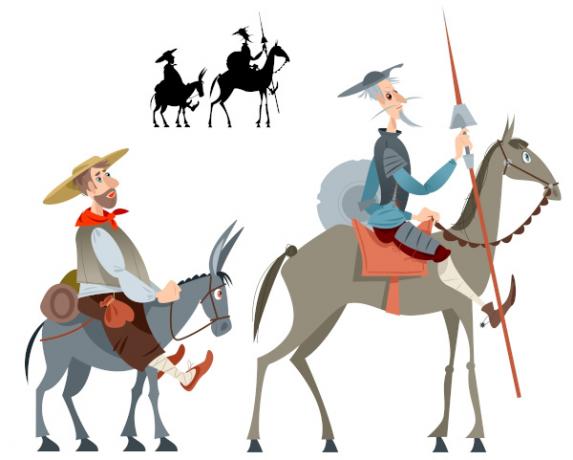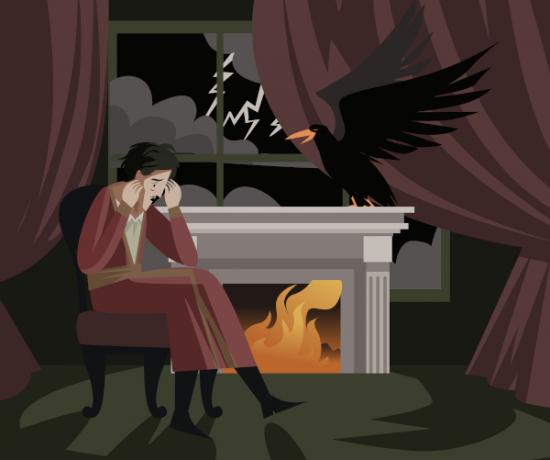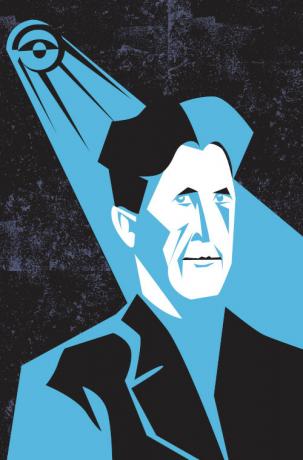You 20 classics of world literature presented here are part of the Western literary tradition, therefore, they are works that have survived time and have universal themes. They belong to various period styles, in addition to presenting authorial elements. Are they:
Iliad;
The divine Comedy;
Hamlet;
Don Quixote;
Faust;
Pride and Prejudice;
frankenstein;
The three Musketeers;
The crow;
moby dick;
Madame Bovary;
The Flowers of Evil;
The miserable;
The Doctor and the Monster;
The portrait of Dorian Gray;
In search of lost time;
Ulysses;
Mrs. Dalloway;
brave world novO;
1984.
Read too:20 classic works of Brazilian literature
Iliad, by Homer
A Iliad é one of the first works of western literature. Attributed to Homer, it dates from approximately the 8th century BC. W. Initially it was sung by rhapsodes. Only later did it take the form of written text. This ancient Greek epic poem recounts events at the end of the Trojan War.
O protagonist is Achilles, who disputes power with Agamemnon, who provokes the wrath of the great hero. Thus, when Achilles abandons combat, the Greek army begins to suffer numerous casualties; however, when Patroclus is killed in battle, Achilles returns to the fight to avenge the death of his beloved, killing the Trojan hero Hector.
The divine Comedyby Dante Alighieri
Narrative in Verses Italian poet Dante Alighieri, The divine Comedy he was written in the fourteenth century. The story takes place in three spaces, namely hell, purgatory and paradise. Dante is the protagonist of the narrative. He is guided by the soul of the poet Virgil, who, being a pagan, just cannot enter paradise.
The work thus mixes the medieval theocentric vision with the anthropocentric perspective of antiquity. During the crossing, the narrator presents the suffering of souls in hell and purgatory, until he reaches paradise, where he finds Beatriz's soul. His beloved's generosity is responsible for Dante's salvation. To learn more about the work, click here.
Hamletby William Shakespeare
One of the main works of English author William Shakespeare, Hamlet is play written around 1600. This tragedy centers on the revenge of the Prince of Denmark, whose father was murdered by his own brother. After receiving a visit from his father's ghost, Hamlet decides to take revenge on his mother and uncle, who criminally usurped the king's throne. So, the hero pretends to be crazy in order to unmask the villains.
Don Quixoteby Miguel de Cervantes

the spanish romance Don Quixote (or The ingenious nobleman Don Quixote of la Mancha) he was first published in 1605. So, after reading several chivalric novels, Alonso Quijano, the protagonist of the narrative, goes crazy and starts to believe that he himself is a medieval knight.
Thus, in the company of his faithful squire Sancho Panza (a realist, as opposed to quixotic fantasy), the protagonist seeks adventures in the lands of Spain. As it couldn't be otherwise, the madman needs a lady to dedicate his pure love to. Then he falls in love with the idealized Dulcinea.
Faust, by Johann Wolfgang von Goethe
the play Faust, from 1806, is one of the best known Goethe's works, German writer. It is named after its protagonist, an honest and apparently good man. Until the demon Mephistopheles, to prove to God that every human being is corrupt, promises to give Faust everything he asks for in exchange for his soul.
Thus, the protagonist shows himself to be ambitious and thirsty for power by making a pact with the devil. From then on, Fausto regains his youth and seduces the beautiful Margarida. However, the fulfillment of his desires is accompanied by tragedy. Thus, the protagonist's happy ending can only occur with his regret.
Pride and Prejudiceby Jane Austen
Pride and Prejudice, from the English author Jane Austen, was first published in 1813. In that english novel, the protagonists are Elizabeth Bennet and Fitzwilliam Darcy. Initially, the heroine dislikes the hero when he is ignored, however, as the plot unfolds, she realizes how much the boy is worthy of her love.
At the same time, we have the love story between Bingley and Jane, Elizabeth's sister. However, their relationship is shaken by the difference in class, as the girl is poorer than the boy. Thus, the work speaks of the pride of the young protagonist Elizabeth and the prejudice suffered by her family. For both love stories to have a happy ending, both pride and prejudice must be overcome.
Anyway, the protagonist of this novel is a strong female character. Elizabeth is intelligent, realistic and possesses independence of action and thought. It is also worth mentioning the ironic tone present in this work, which calls into question the customs of English society at the beginning of the 19th century.
frankenstein, by Mary Shelley
First published in 1818, frankenstein é a classic of english romanticism. In that novel, Victor Frankenstein decides to build a man. In this attempt, the protagonist ends up creating a monster. Abandoned by its creator, the creature must learn to survive on its own.
The solitary life and the feeling of rejection make the creature develop a grudge against its creator. The monster kills Frankenstein's younger brother. Still, he asks his creator to make him a companion, otherwise he won't leave him alone. In the middle of this process, however, the scientist gives up on creating another monster.
In revenge, the creature kills Elizabeth, Frankenstein's wife. Having his life destroyed by the monster, the scientist decides to hunt and kill the creature. This is how the plot of this book develops, which reflects on the limits and dangers of science, in addition to exposing human limitations.
The three Musketeers, by Alexandre Dumas
The three Musketeersis a French novel from 1844, of French writer Alexandre Dumas, which tells the adventures of the hero D'Artagnan, a young man who dreams of being one of the king of France's musketeers, in the 17th century. He has the support of the musketeers Athos, Porthos and Aramis. The story's villains are Cardinal Richelieu, who uses his political power for evil, and Milady de Winter, a runaway criminal. The love story is on account of the hero and the idealized Constance.
The crowby Edgar Allan Poe

Short narrative poem from 1845, by American Edgar Allan Poe, The crowhas a dark character. After losing his beloved Lenora, a man is visited by a talking crow in the night. Mysteriously and disturbingly, the crow repeats the expression "never again" (in English, never more).
moby dick, by Hermann Melville
The American Romance moby dick he was first published in 1851. In this work, Captain Ahab crosses the sea in a relentless search for the whale Moby Dick. Ahab wants revenge for the incident where she was responsible for the mutilation of part of one of her legs. Thus, the work reaches its peak when showing the tragic final fight between the obstinate captain and the giant of the sea.
Madame Bovaryby Gustave Flaubert
First published in 1857, the French and realistic romanceMadame Bovary, of French author Gustave Flaubert, has as protagonist Emma Bovary, married to the modest doctor Charles Bovary. Disappointed with the reality of bourgeois marriage, the heroine ends up having extramarital affairs, as she seeks the happiness promised in romantic books.
As reality is far from the idealization of the books she read, her lovers Léon Dupuis and Rodolphe Boulanger also disappoint her. The character, taken by boredom and dissatisfaction, ends up finding depression. And, to escape the unbearable reality, he sees no other way than death.
The Flowers of Evilby Charles Baudelaire
The Flowers of Evil, poetry book of French Charles Baudelaire, was first published in 1857. The work, precursor of symbolism, presents synesthesia, formal rigor and musicality. The dark, melancholy and pessimistic tone is used to talk about themes like love, boredom and death. At the time, some poems were censored for attacking “against morals and good customs”.
The miserable, by Victor Hugo
At the french novelThe miserable, 1862, Jean Valjean receives an inhumane sentence of forced labor after stealing a loaf of bread to satisfy hunger. Nineteen years later, he is released. However, the fact that he is an ex-convict prevents him from getting a job. Thus, the hero assumes a new identity and becomes known under the name of Madeleine.
After a lot of work, he becomes the owner of a factory, becomes rich and receives the respect of the whole society. He also adopts the small and suffering Cosette and thus forms a family. Later, Cosette marries young Marius. Everything would be perfect if not for Inspector Javert, who is aware of the true identity of the respectable Madeleine and will do everything to destroy her honor.
The Doctor and the Monsterby Robert Louis Stevenson
From 1886, The Doctor and the Monster é a work of Scottish literature. The narrative features two central characters: Henry Jekyll and Edward Hyde. However, these two personalities occupy the same body, and are opposites, as Jekyll represents good, while Hyde, evil. The story takes place in the city of London, England.
The personalities are so disparate that it even changes the body they occupy, so that, when seeing Hyde, a person does not associate him with Jekyll. That's because Hyde appears when Doctor Jekyll takes a potion that lets the unscrupulous killer possess the body of the scientist, a body that must belong to only one of them.
The portrait of Dorian Gray, by Oscar Wilde
the only novel Irish writer Oscar Wilde, The portrait of Dorian Gray, from 1890, is a work that praises beauty but also points out the dark aspect of the human mind. Enchanted by the beauty of Dorian Gray, painter Basil Hallward decides to paint the boy. Also fascinated by the young man, Lord Henry convinces Gray to experience the pleasures of life.
The beauty of Dorian Gray, which should be preserved in painting, ends up being preserved in the boy, who does not age. The young man in the portrait, on the other hand, is marked by time and has the traits of evil. In this way, the portrait, locked in a room, shows who the real Dorian Gray is, while the boy's beautiful appearance hides the corruption inherent in the human being.
In search of lost timeby Marcel Proust
Published between 1913 and 1927, The work In search of lost time, of French Marcel Proust, has seven volumes, titled as follows: “On the path of Swann”, “In the shadow of the girls in bloom”, “The path of Guermantes”, “Sodom and Gomorrah”, “The prisoner”, “The fugitive” and “Time rediscovered”. Through them, the narrator relates events of his life from childhood to maturity.
A work is autobiographical, that is, there are elements of the author's life in it. The protagonist and narrator resorts to the stream of consciousness to analyze his life experiences, related to the daily life of the decadent aristocracy, which was losing ground to the French bourgeoisie. The work presents more reflections than events and analyzes, mainly, the passage of time and the changes it causes.
Ulysses, by James Joyce
In clear dialogue with the Odyssey, from Homer, the Irish Romance Ulysses, from 1922, features an ordinary man named Leopold Bloom as the protagonist. Like the epic hero, he also returns home, but his adventures take place in just one day, specifically June 16, 1904, in Dublin.
O book is marked by interior monologue, unconventional structure and use of numerous neologisms. Thus, Joyce it unites Antiquity with Modernity, the epic hero with the modern common man, tradition with innovation. Ulysses impresses with its elaborate, artistic language.
Mrs. Dallowayby Virginia Woolf
the english novel Mrs. Dalloway, from 1925, follows the trend of European modernist novels from the beginning of the 20th century, since presents a narrative in which the stream of consciousness predominates. In this work of English writer Virginia Woolf, the narrator shows a day in the life of a wealthy housewife named Clarissa Dalloway, who is busy preparing for a party in London.
Another central character is former soldier Septimus Warren Smith. He needs to live with the traumas obtained in the First World War and with the memory of the possible passion he felt for a friend killed in the war, named Evans. This kind of love was also experienced by Mrs. Dalloway in her youth, when she was in love with her friend Sally.
Admirable new worldby Aldous Huxley
the english novel Admirable new world, from 1932, it's a dystopian narrative of English writer Aldous Huxley that shows a future with people alienated by technology and the use of the drug "soma". The story takes place in the year 632 AD. F. (after Ford). Science prevails, and people are raised in the Incubation and Conditioning Center, where each individual's social class is determined.
You Central characters are Bernard Marx and Lenina Crowne, superior class. On a walk in a wild reserve (individuals that are born by the natural process), they meet Linda and her son John, and take the two out of the reserve. In the “brave new world”, John the Savage starts to criticize that society, in order to show that it has nothing perfect.
1984by George Orwell

the english novel 1984 é another dystopian narrative that shows a dark future, in this case, the year 1984, when Big Brother controls the lives of citizens. Published for the first time in 1949, the work shows a society constantly under surveillance, where History is constantly manipulated and rewritten by the Ministry of Truth.
However, the protagonist Winston Smith begins to question that whole system. Thus, you run a great risk, as everyone lives under constant control, so that even your thoughts are watched. That way, orwell criticizes the totalitarianism of his time and alerts to the existence of future totalitarianisms.
image credits
[1] Radiokafka / Shutterstock
[2] Mario Breda / Shutterstock
By Warley Souza
Literature Teacher
Source: Brazil School - https://brasilescola.uol.com.br/literatura/20-classicos-da-literatura-mundial.htm

